International Business Issues: IKEA Project Management and Risk Report
VerifiedAdded on 2021/06/30
|26
|6371
|49
Report
AI Summary
This report critically analyzes IKEA's project management practices, particularly focusing on how the company manages and mitigates risks to achieve its strategic goals, especially its 'People and Planet Positive' sustainability strategy. The report begins with a literature review defining project management and its key areas, including project lifecycle, team dynamics, and risk management processes. It then examines IKEA's approach to project management, risk mitigation strategies, and how these practices impact the company's success and failures. The analysis includes an evaluation of IKEA's sustainability projects aimed at becoming a circular and climate-positive business by 2030. The report concludes with findings, recommendations, and discussions on alternative directions for addressing specific business issues and practices, providing insights into how IKEA navigates the challenges of international business and sustainability in a dynamic market.
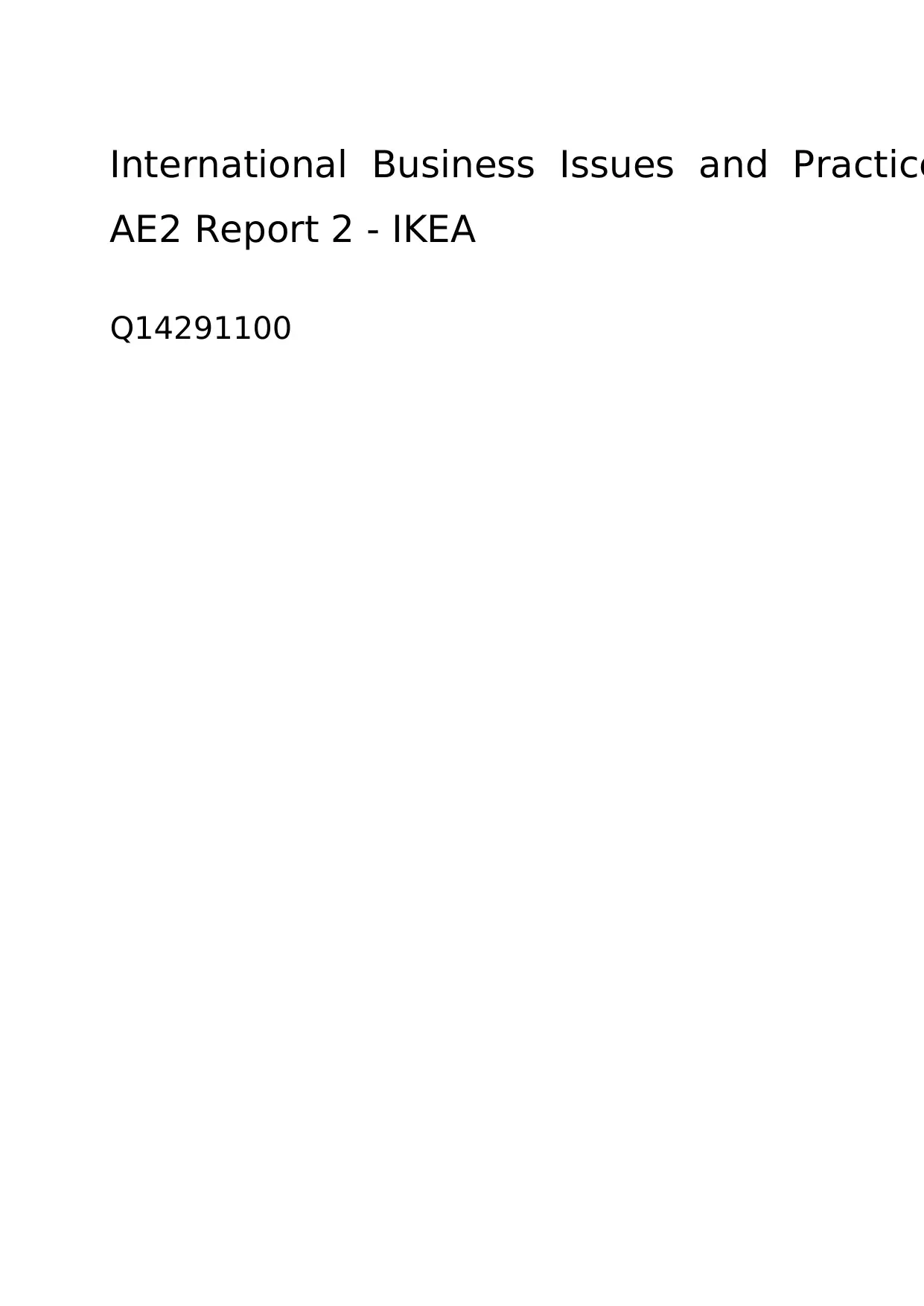
International Business Issues and Practice
AE2 Report 2 - IKEA
Q14291100
AE2 Report 2 - IKEA
Q14291100
Paraphrase This Document
Need a fresh take? Get an instant paraphrase of this document with our AI Paraphraser
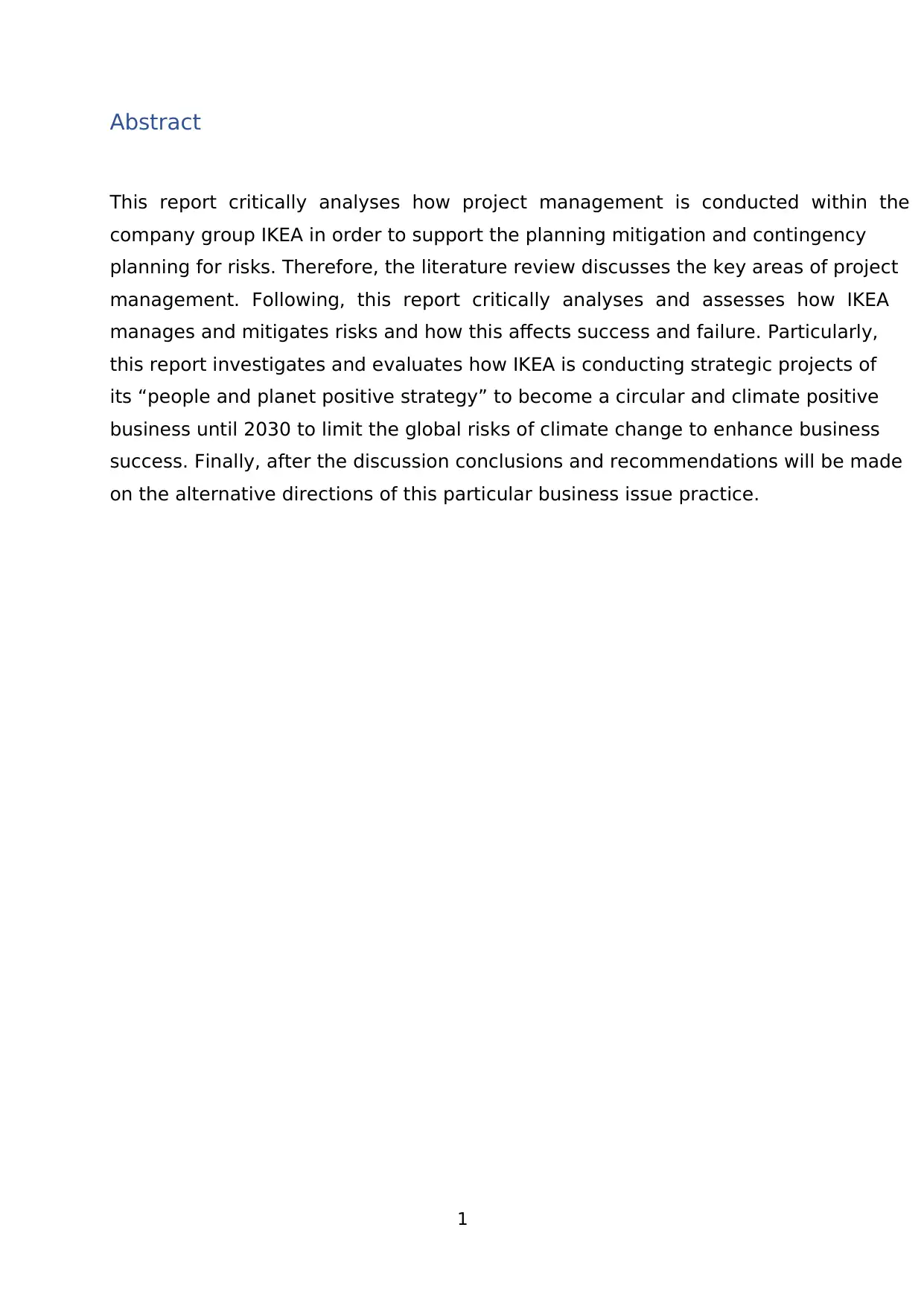
1
Abstract
This report critically analyses how project management is conducted within the
company group IKEA in order to support the planning mitigation and contingency
planning for risks. Therefore, the literature review discusses the key areas of project
management. Following, this report critically analyses and assesses how IKEA
manages and mitigates risks and how this affects success and failure. Particularly,
this report investigates and evaluates how IKEA is conducting strategic projects of
its “people and planet positive strategy” to become a circular and climate positive
business until 2030 to limit the global risks of climate change to enhance business
success. Finally, after the discussion conclusions and recommendations will be made
on the alternative directions of this particular business issue practice.
Abstract
This report critically analyses how project management is conducted within the
company group IKEA in order to support the planning mitigation and contingency
planning for risks. Therefore, the literature review discusses the key areas of project
management. Following, this report critically analyses and assesses how IKEA
manages and mitigates risks and how this affects success and failure. Particularly,
this report investigates and evaluates how IKEA is conducting strategic projects of
its “people and planet positive strategy” to become a circular and climate positive
business until 2030 to limit the global risks of climate change to enhance business
success. Finally, after the discussion conclusions and recommendations will be made
on the alternative directions of this particular business issue practice.
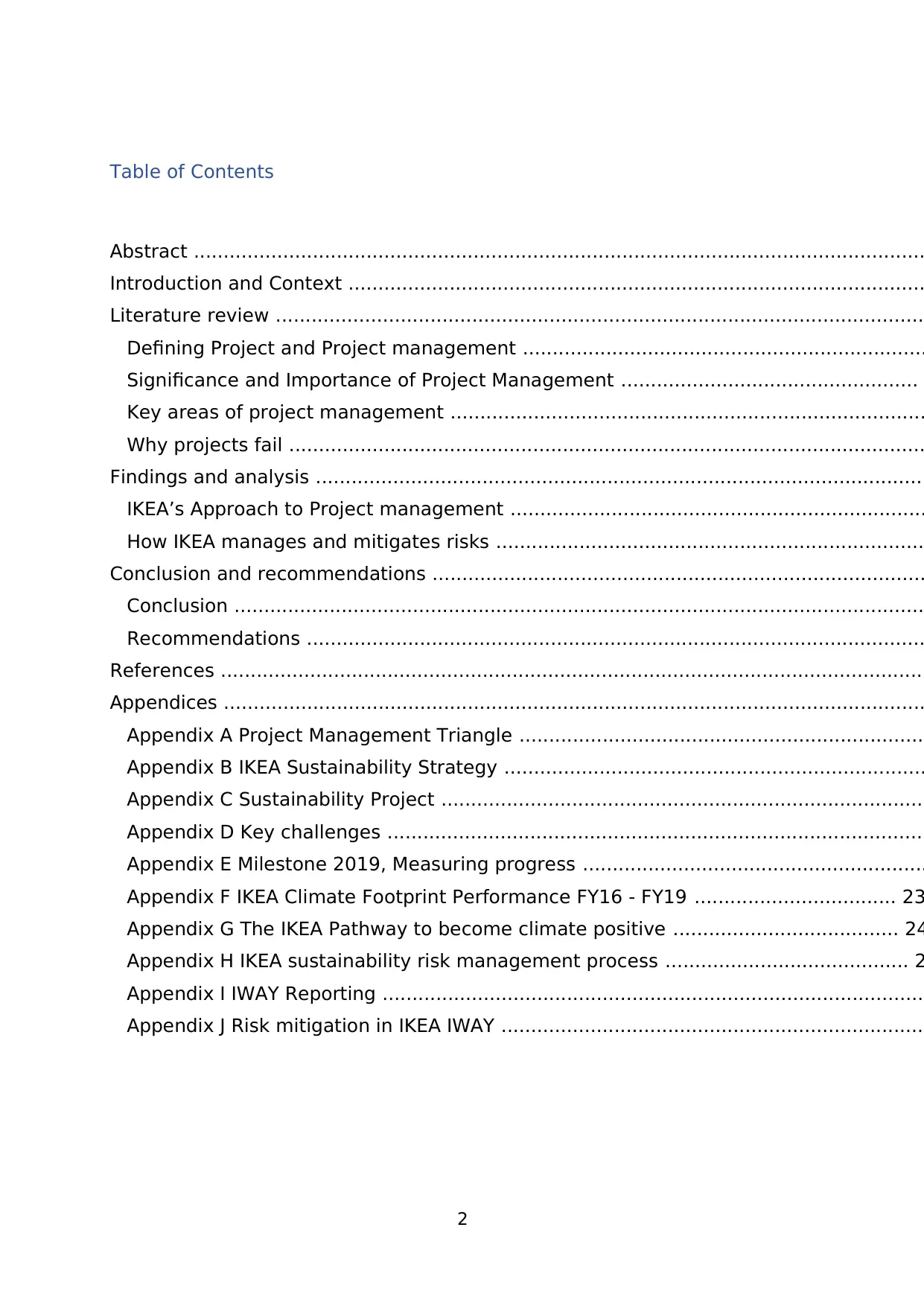
2
Table of Contents
Abstract ...........................................................................................................................
Introduction and Context .................................................................................................
Literature review .............................................................................................................
Defining Project and Project management ....................................................................
Significance and Importance of Project Management ..................................................
Key areas of project management ................................................................................
Why projects fail ...........................................................................................................
Findings and analysis .......................................................................................................
IKEA’s Approach to Project management ......................................................................
How IKEA manages and mitigates risks ........................................................................
Conclusion and recommendations ...................................................................................
Conclusion ....................................................................................................................
Recommendations ........................................................................................................
References .......................................................................................................................
Appendices ......................................................................................................................
Appendix A Project Management Triangle ....................................................................
Appendix B IKEA Sustainability Strategy .......................................................................
Appendix C Sustainability Project ..................................................................................
Appendix D Key challenges ...........................................................................................
Appendix E Milestone 2019, Measuring progress ..........................................................
Appendix F IKEA Climate Footprint Performance FY16 - FY19 .................................. 23
Appendix G The IKEA Pathway to become climate positive ...................................... 24
Appendix H IKEA sustainability risk management process ......................................... 2
Appendix I IWAY Reporting ...........................................................................................
Appendix J Risk mitigation in IKEA IWAY .......................................................................
Table of Contents
Abstract ...........................................................................................................................
Introduction and Context .................................................................................................
Literature review .............................................................................................................
Defining Project and Project management ....................................................................
Significance and Importance of Project Management ..................................................
Key areas of project management ................................................................................
Why projects fail ...........................................................................................................
Findings and analysis .......................................................................................................
IKEA’s Approach to Project management ......................................................................
How IKEA manages and mitigates risks ........................................................................
Conclusion and recommendations ...................................................................................
Conclusion ....................................................................................................................
Recommendations ........................................................................................................
References .......................................................................................................................
Appendices ......................................................................................................................
Appendix A Project Management Triangle ....................................................................
Appendix B IKEA Sustainability Strategy .......................................................................
Appendix C Sustainability Project ..................................................................................
Appendix D Key challenges ...........................................................................................
Appendix E Milestone 2019, Measuring progress ..........................................................
Appendix F IKEA Climate Footprint Performance FY16 - FY19 .................................. 23
Appendix G The IKEA Pathway to become climate positive ...................................... 24
Appendix H IKEA sustainability risk management process ......................................... 2
Appendix I IWAY Reporting ...........................................................................................
Appendix J Risk mitigation in IKEA IWAY .......................................................................
⊘ This is a preview!⊘
Do you want full access?
Subscribe today to unlock all pages.

Trusted by 1+ million students worldwide
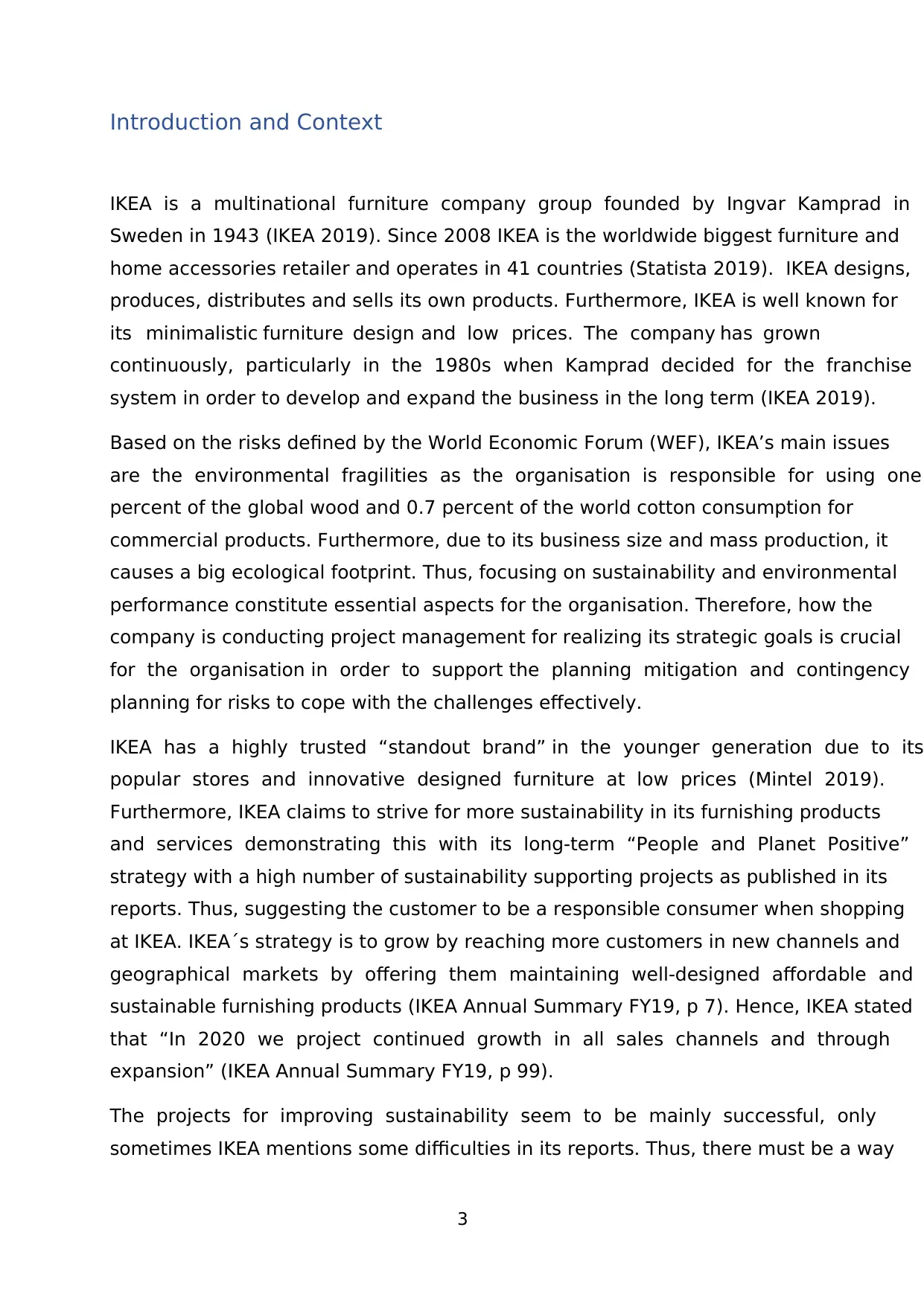
3
Introduction and Context
IKEA is a multinational furniture company group founded by Ingvar Kamprad in
Sweden in 1943 (IKEA 2019). Since 2008 IKEA is the worldwide biggest furniture and
home accessories retailer and operates in 41 countries (Statista 2019). IKEA designs,
produces, distributes and sells its own products. Furthermore, IKEA is well known for
its minimalistic furniture design and low prices. The company has grown
continuously, particularly in the 1980s when Kamprad decided for the franchise
system in order to develop and expand the business in the long term (IKEA 2019).
Based on the risks defined by the World Economic Forum (WEF), IKEA’s main issues
are the environmental fragilities as the organisation is responsible for using one
percent of the global wood and 0.7 percent of the world cotton consumption for
commercial products. Furthermore, due to its business size and mass production, it
causes a big ecological footprint. Thus, focusing on sustainability and environmental
performance constitute essential aspects for the organisation. Therefore, how the
company is conducting project management for realizing its strategic goals is crucial
for the organisation in order to support the planning mitigation and contingency
planning for risks to cope with the challenges effectively.
IKEA has a highly trusted “standout brand” in the younger generation due to its
popular stores and innovative designed furniture at low prices (Mintel 2019).
Furthermore, IKEA claims to strive for more sustainability in its furnishing products
and services demonstrating this with its long-term “People and Planet Positive”
strategy with a high number of sustainability supporting projects as published in its
reports. Thus, suggesting the customer to be a responsible consumer when shopping
at IKEA. IKEA´s strategy is to grow by reaching more customers in new channels and
geographical markets by offering them maintaining well-designed affordable and
sustainable furnishing products (IKEA Annual Summary FY19, p 7). Hence, IKEA stated
that “In 2020 we project continued growth in all sales channels and through
expansion” (IKEA Annual Summary FY19, p 99).
The projects for improving sustainability seem to be mainly successful, only
sometimes IKEA mentions some difficulties in its reports. Thus, there must be a way
Introduction and Context
IKEA is a multinational furniture company group founded by Ingvar Kamprad in
Sweden in 1943 (IKEA 2019). Since 2008 IKEA is the worldwide biggest furniture and
home accessories retailer and operates in 41 countries (Statista 2019). IKEA designs,
produces, distributes and sells its own products. Furthermore, IKEA is well known for
its minimalistic furniture design and low prices. The company has grown
continuously, particularly in the 1980s when Kamprad decided for the franchise
system in order to develop and expand the business in the long term (IKEA 2019).
Based on the risks defined by the World Economic Forum (WEF), IKEA’s main issues
are the environmental fragilities as the organisation is responsible for using one
percent of the global wood and 0.7 percent of the world cotton consumption for
commercial products. Furthermore, due to its business size and mass production, it
causes a big ecological footprint. Thus, focusing on sustainability and environmental
performance constitute essential aspects for the organisation. Therefore, how the
company is conducting project management for realizing its strategic goals is crucial
for the organisation in order to support the planning mitigation and contingency
planning for risks to cope with the challenges effectively.
IKEA has a highly trusted “standout brand” in the younger generation due to its
popular stores and innovative designed furniture at low prices (Mintel 2019).
Furthermore, IKEA claims to strive for more sustainability in its furnishing products
and services demonstrating this with its long-term “People and Planet Positive”
strategy with a high number of sustainability supporting projects as published in its
reports. Thus, suggesting the customer to be a responsible consumer when shopping
at IKEA. IKEA´s strategy is to grow by reaching more customers in new channels and
geographical markets by offering them maintaining well-designed affordable and
sustainable furnishing products (IKEA Annual Summary FY19, p 7). Hence, IKEA stated
that “In 2020 we project continued growth in all sales channels and through
expansion” (IKEA Annual Summary FY19, p 99).
The projects for improving sustainability seem to be mainly successful, only
sometimes IKEA mentions some difficulties in its reports. Thus, there must be a way
Paraphrase This Document
Need a fresh take? Get an instant paraphrase of this document with our AI Paraphraser
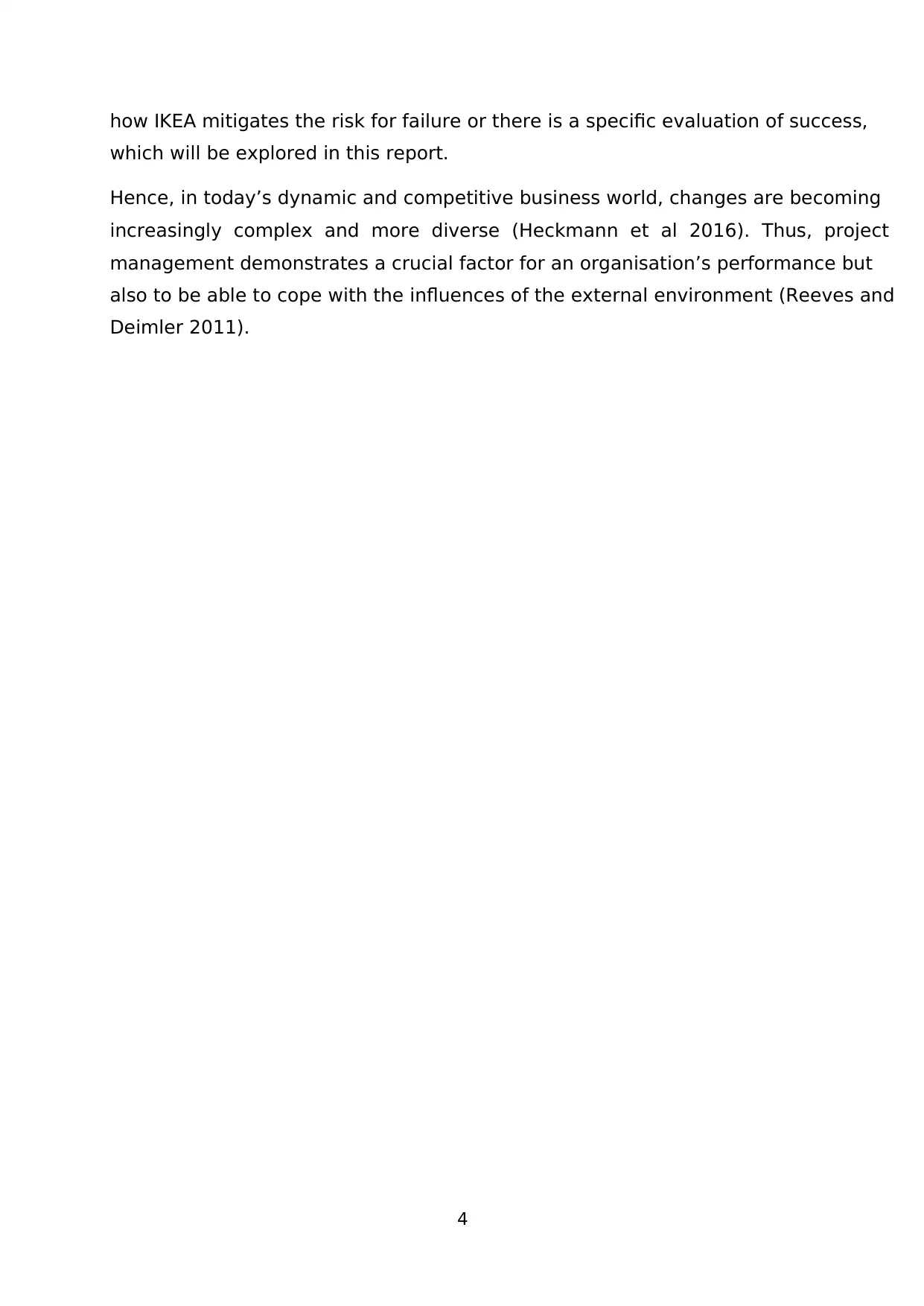
4
how IKEA mitigates the risk for failure or there is a specific evaluation of success,
which will be explored in this report.
Hence, in today’s dynamic and competitive business world, changes are becoming
increasingly complex and more diverse (Heckmann et al 2016). Thus, project
management demonstrates a crucial factor for an organisation’s performance but
also to be able to cope with the influences of the external environment (Reeves and
Deimler 2011).
how IKEA mitigates the risk for failure or there is a specific evaluation of success,
which will be explored in this report.
Hence, in today’s dynamic and competitive business world, changes are becoming
increasingly complex and more diverse (Heckmann et al 2016). Thus, project
management demonstrates a crucial factor for an organisation’s performance but
also to be able to cope with the influences of the external environment (Reeves and
Deimler 2011).
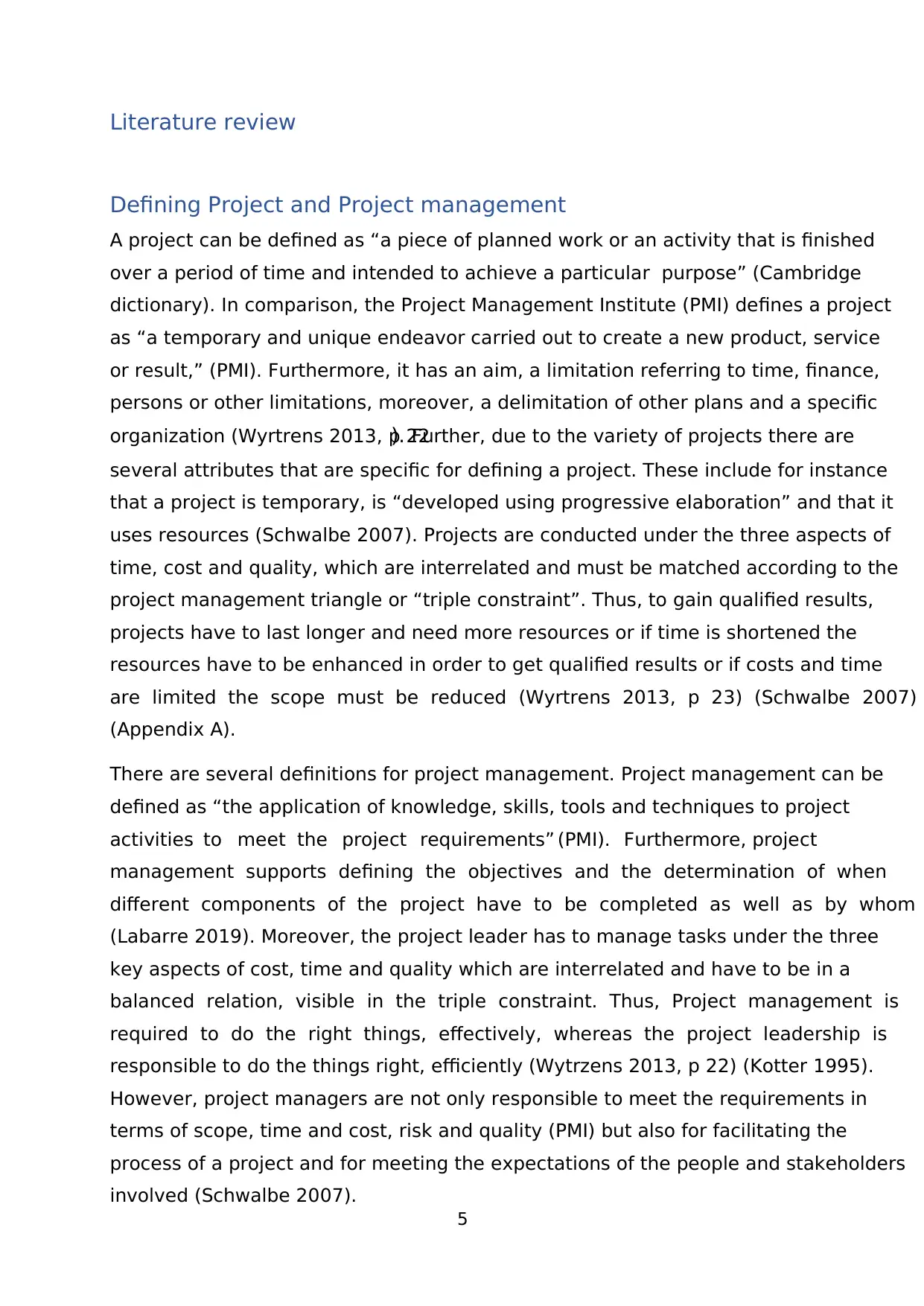
5
Literature review
Defining Project and Project management
A project can be defined as “a piece of planned work or an activity that is finished
over a period of time and intended to achieve a particular purpose” (Cambridge
dictionary). In comparison, the Project Management Institute (PMI) defines a project
as “a temporary and unique endeavor carried out to create a new product, service
or result,” (PMI). Furthermore, it has an aim, a limitation referring to time, finance,
persons or other limitations, moreover, a delimitation of other plans and a specific
organization (Wyrtrens 2013, p 22). Further, due to the variety of projects there are
several attributes that are specific for defining a project. These include for instance
that a project is temporary, is “developed using progressive elaboration” and that it
uses resources (Schwalbe 2007). Projects are conducted under the three aspects of
time, cost and quality, which are interrelated and must be matched according to the
project management triangle or “triple constraint”. Thus, to gain qualified results,
projects have to last longer and need more resources or if time is shortened the
resources have to be enhanced in order to get qualified results or if costs and time
are limited the scope must be reduced (Wyrtrens 2013, p 23) (Schwalbe 2007)
(Appendix A).
There are several definitions for project management. Project management can be
defined as “the application of knowledge, skills, tools and techniques to project
activities to meet the project requirements” (PMI). Furthermore, project
management supports defining the objectives and the determination of when
different components of the project have to be completed as well as by whom
(Labarre 2019). Moreover, the project leader has to manage tasks under the three
key aspects of cost, time and quality which are interrelated and have to be in a
balanced relation, visible in the triple constraint. Thus, Project management is
required to do the right things, effectively, whereas the project leadership is
responsible to do the things right, efficiently (Wytrzens 2013, p 22) (Kotter 1995).
However, project managers are not only responsible to meet the requirements in
terms of scope, time and cost, risk and quality (PMI) but also for facilitating the
process of a project and for meeting the expectations of the people and stakeholders
involved (Schwalbe 2007).
Literature review
Defining Project and Project management
A project can be defined as “a piece of planned work or an activity that is finished
over a period of time and intended to achieve a particular purpose” (Cambridge
dictionary). In comparison, the Project Management Institute (PMI) defines a project
as “a temporary and unique endeavor carried out to create a new product, service
or result,” (PMI). Furthermore, it has an aim, a limitation referring to time, finance,
persons or other limitations, moreover, a delimitation of other plans and a specific
organization (Wyrtrens 2013, p 22). Further, due to the variety of projects there are
several attributes that are specific for defining a project. These include for instance
that a project is temporary, is “developed using progressive elaboration” and that it
uses resources (Schwalbe 2007). Projects are conducted under the three aspects of
time, cost and quality, which are interrelated and must be matched according to the
project management triangle or “triple constraint”. Thus, to gain qualified results,
projects have to last longer and need more resources or if time is shortened the
resources have to be enhanced in order to get qualified results or if costs and time
are limited the scope must be reduced (Wyrtrens 2013, p 23) (Schwalbe 2007)
(Appendix A).
There are several definitions for project management. Project management can be
defined as “the application of knowledge, skills, tools and techniques to project
activities to meet the project requirements” (PMI). Furthermore, project
management supports defining the objectives and the determination of when
different components of the project have to be completed as well as by whom
(Labarre 2019). Moreover, the project leader has to manage tasks under the three
key aspects of cost, time and quality which are interrelated and have to be in a
balanced relation, visible in the triple constraint. Thus, Project management is
required to do the right things, effectively, whereas the project leadership is
responsible to do the things right, efficiently (Wytrzens 2013, p 22) (Kotter 1995).
However, project managers are not only responsible to meet the requirements in
terms of scope, time and cost, risk and quality (PMI) but also for facilitating the
process of a project and for meeting the expectations of the people and stakeholders
involved (Schwalbe 2007).
⊘ This is a preview!⊘
Do you want full access?
Subscribe today to unlock all pages.

Trusted by 1+ million students worldwide
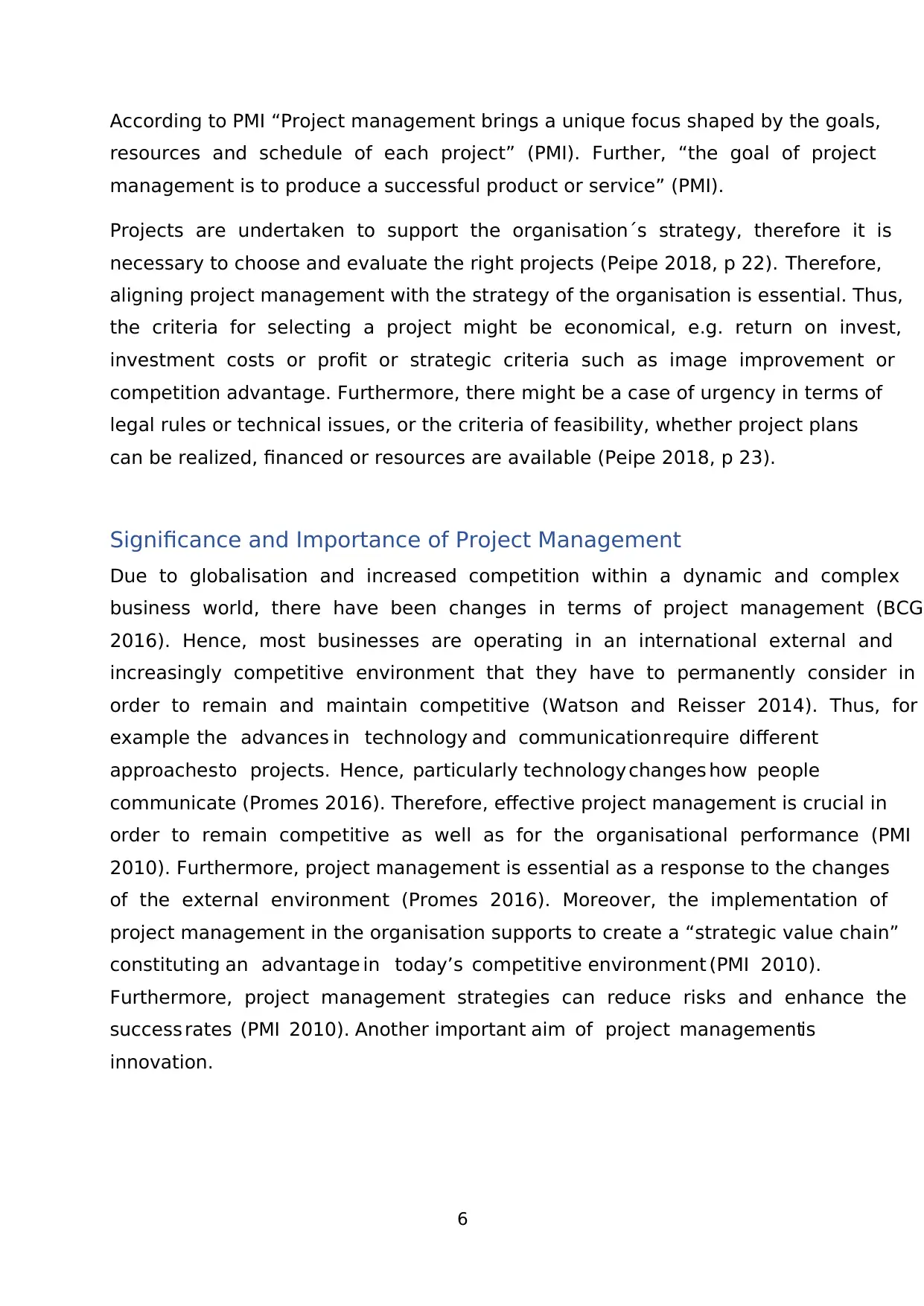
6
According to PMI “Project management brings a unique focus shaped by the goals,
resources and schedule of each project” (PMI). Further, “the goal of project
management is to produce a successful product or service” (PMI).
Projects are undertaken to support the organisation´s strategy, therefore it is
necessary to choose and evaluate the right projects (Peipe 2018, p 22). Therefore,
aligning project management with the strategy of the organisation is essential. Thus,
the criteria for selecting a project might be economical, e.g. return on invest,
investment costs or profit or strategic criteria such as image improvement or
competition advantage. Furthermore, there might be a case of urgency in terms of
legal rules or technical issues, or the criteria of feasibility, whether project plans
can be realized, financed or resources are available (Peipe 2018, p 23).
Significance and Importance of Project Management
Due to globalisation and increased competition within a dynamic and complex
business world, there have been changes in terms of project management (BCG
2016). Hence, most businesses are operating in an international external and
increasingly competitive environment that they have to permanently consider in
order to remain and maintain competitive (Watson and Reisser 2014). Thus, for
example the advances in technology and communication require different
approaches to projects. Hence, particularly technology changes how people
communicate (Promes 2016). Therefore, effective project management is crucial in
order to remain competitive as well as for the organisational performance (PMI
2010). Furthermore, project management is essential as a response to the changes
of the external environment (Promes 2016). Moreover, the implementation of
project management in the organisation supports to create a “strategic value chain”
constituting an advantage in today’s competitive environment (PMI 2010).
Furthermore, project management strategies can reduce risks and enhance the
success rates (PMI 2010). Another important aim of project managementis
innovation.
According to PMI “Project management brings a unique focus shaped by the goals,
resources and schedule of each project” (PMI). Further, “the goal of project
management is to produce a successful product or service” (PMI).
Projects are undertaken to support the organisation´s strategy, therefore it is
necessary to choose and evaluate the right projects (Peipe 2018, p 22). Therefore,
aligning project management with the strategy of the organisation is essential. Thus,
the criteria for selecting a project might be economical, e.g. return on invest,
investment costs or profit or strategic criteria such as image improvement or
competition advantage. Furthermore, there might be a case of urgency in terms of
legal rules or technical issues, or the criteria of feasibility, whether project plans
can be realized, financed or resources are available (Peipe 2018, p 23).
Significance and Importance of Project Management
Due to globalisation and increased competition within a dynamic and complex
business world, there have been changes in terms of project management (BCG
2016). Hence, most businesses are operating in an international external and
increasingly competitive environment that they have to permanently consider in
order to remain and maintain competitive (Watson and Reisser 2014). Thus, for
example the advances in technology and communication require different
approaches to projects. Hence, particularly technology changes how people
communicate (Promes 2016). Therefore, effective project management is crucial in
order to remain competitive as well as for the organisational performance (PMI
2010). Furthermore, project management is essential as a response to the changes
of the external environment (Promes 2016). Moreover, the implementation of
project management in the organisation supports to create a “strategic value chain”
constituting an advantage in today’s competitive environment (PMI 2010).
Furthermore, project management strategies can reduce risks and enhance the
success rates (PMI 2010). Another important aim of project managementis
innovation.
Paraphrase This Document
Need a fresh take? Get an instant paraphrase of this document with our AI Paraphraser
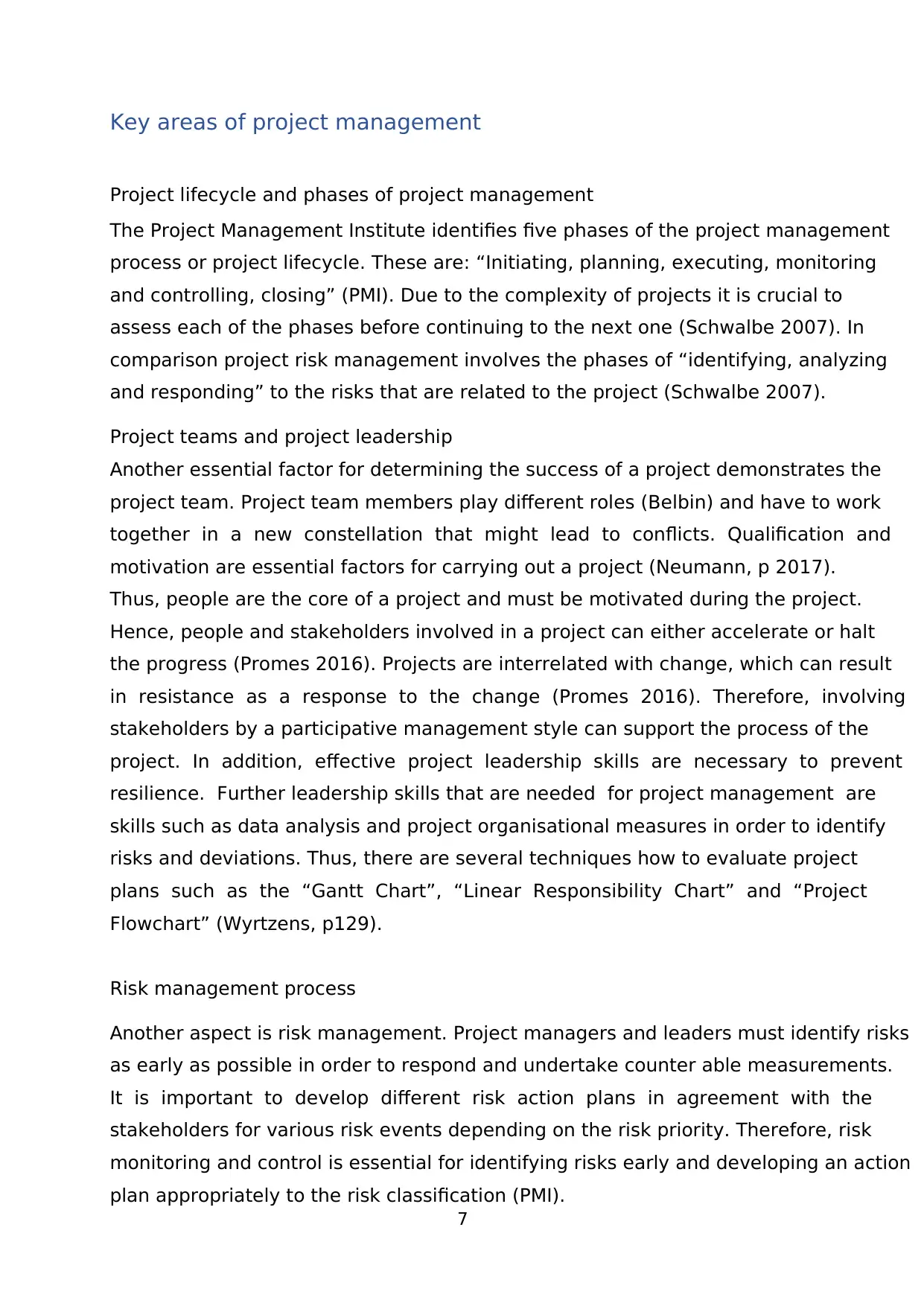
7
Key areas of project management
Project lifecycle and phases of project management
The Project Management Institute identifies five phases of the project management
process or project lifecycle. These are: “Initiating, planning, executing, monitoring
and controlling, closing” (PMI). Due to the complexity of projects it is crucial to
assess each of the phases before continuing to the next one (Schwalbe 2007). In
comparison project risk management involves the phases of “identifying, analyzing
and responding” to the risks that are related to the project (Schwalbe 2007).
Project teams and project leadership
Another essential factor for determining the success of a project demonstrates the
project team. Project team members play different roles (Belbin) and have to work
together in a new constellation that might lead to conflicts. Qualification and
motivation are essential factors for carrying out a project (Neumann, p 2017).
Thus, people are the core of a project and must be motivated during the project.
Hence, people and stakeholders involved in a project can either accelerate or halt
the progress (Promes 2016). Projects are interrelated with change, which can result
in resistance as a response to the change (Promes 2016). Therefore, involving
stakeholders by a participative management style can support the process of the
project. In addition, effective project leadership skills are necessary to prevent
resilience. Further leadership skills that are needed for project management are
skills such as data analysis and project organisational measures in order to identify
risks and deviations. Thus, there are several techniques how to evaluate project
plans such as the “Gantt Chart”, “Linear Responsibility Chart” and “Project
Flowchart” (Wyrtzens, p129).
Risk management process
Another aspect is risk management. Project managers and leaders must identify risks
as early as possible in order to respond and undertake counter able measurements.
It is important to develop different risk action plans in agreement with the
stakeholders for various risk events depending on the risk priority. Therefore, risk
monitoring and control is essential for identifying risks early and developing an action
plan appropriately to the risk classification (PMI).
Key areas of project management
Project lifecycle and phases of project management
The Project Management Institute identifies five phases of the project management
process or project lifecycle. These are: “Initiating, planning, executing, monitoring
and controlling, closing” (PMI). Due to the complexity of projects it is crucial to
assess each of the phases before continuing to the next one (Schwalbe 2007). In
comparison project risk management involves the phases of “identifying, analyzing
and responding” to the risks that are related to the project (Schwalbe 2007).
Project teams and project leadership
Another essential factor for determining the success of a project demonstrates the
project team. Project team members play different roles (Belbin) and have to work
together in a new constellation that might lead to conflicts. Qualification and
motivation are essential factors for carrying out a project (Neumann, p 2017).
Thus, people are the core of a project and must be motivated during the project.
Hence, people and stakeholders involved in a project can either accelerate or halt
the progress (Promes 2016). Projects are interrelated with change, which can result
in resistance as a response to the change (Promes 2016). Therefore, involving
stakeholders by a participative management style can support the process of the
project. In addition, effective project leadership skills are necessary to prevent
resilience. Further leadership skills that are needed for project management are
skills such as data analysis and project organisational measures in order to identify
risks and deviations. Thus, there are several techniques how to evaluate project
plans such as the “Gantt Chart”, “Linear Responsibility Chart” and “Project
Flowchart” (Wyrtzens, p129).
Risk management process
Another aspect is risk management. Project managers and leaders must identify risks
as early as possible in order to respond and undertake counter able measurements.
It is important to develop different risk action plans in agreement with the
stakeholders for various risk events depending on the risk priority. Therefore, risk
monitoring and control is essential for identifying risks early and developing an action
plan appropriately to the risk classification (PMI).
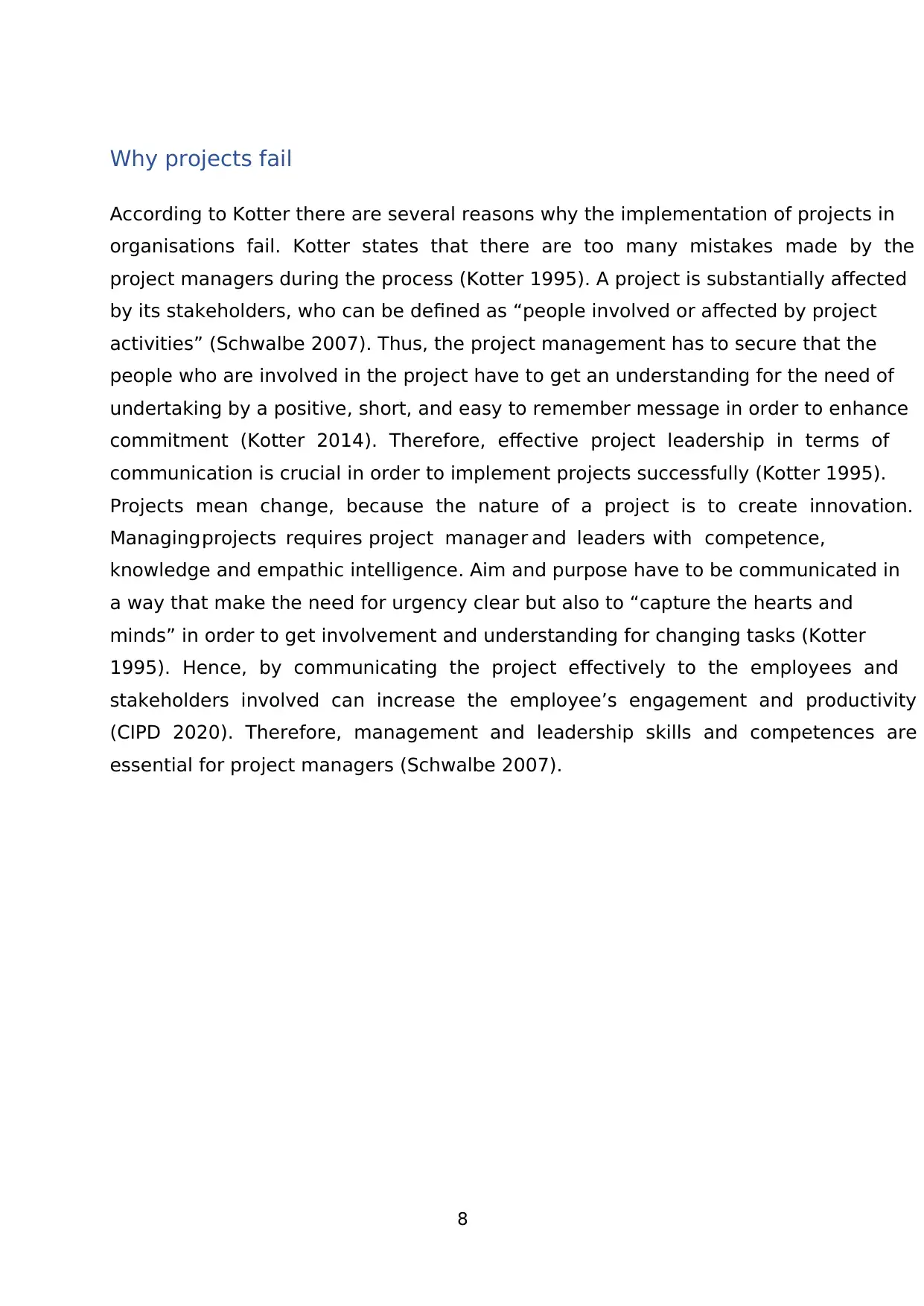
8
Why projects fail
According to Kotter there are several reasons why the implementation of projects in
organisations fail. Kotter states that there are too many mistakes made by the
project managers during the process (Kotter 1995). A project is substantially affected
by its stakeholders, who can be defined as “people involved or affected by project
activities” (Schwalbe 2007). Thus, the project management has to secure that the
people who are involved in the project have to get an understanding for the need of
undertaking by a positive, short, and easy to remember message in order to enhance
commitment (Kotter 2014). Therefore, effective project leadership in terms of
communication is crucial in order to implement projects successfully (Kotter 1995).
Projects mean change, because the nature of a project is to create innovation.
Managing projects requires project manager and leaders with competence,
knowledge and empathic intelligence. Aim and purpose have to be communicated in
a way that make the need for urgency clear but also to “capture the hearts and
minds” in order to get involvement and understanding for changing tasks (Kotter
1995). Hence, by communicating the project effectively to the employees and
stakeholders involved can increase the employee’s engagement and productivity
(CIPD 2020). Therefore, management and leadership skills and competences are
essential for project managers (Schwalbe 2007).
Why projects fail
According to Kotter there are several reasons why the implementation of projects in
organisations fail. Kotter states that there are too many mistakes made by the
project managers during the process (Kotter 1995). A project is substantially affected
by its stakeholders, who can be defined as “people involved or affected by project
activities” (Schwalbe 2007). Thus, the project management has to secure that the
people who are involved in the project have to get an understanding for the need of
undertaking by a positive, short, and easy to remember message in order to enhance
commitment (Kotter 2014). Therefore, effective project leadership in terms of
communication is crucial in order to implement projects successfully (Kotter 1995).
Projects mean change, because the nature of a project is to create innovation.
Managing projects requires project manager and leaders with competence,
knowledge and empathic intelligence. Aim and purpose have to be communicated in
a way that make the need for urgency clear but also to “capture the hearts and
minds” in order to get involvement and understanding for changing tasks (Kotter
1995). Hence, by communicating the project effectively to the employees and
stakeholders involved can increase the employee’s engagement and productivity
(CIPD 2020). Therefore, management and leadership skills and competences are
essential for project managers (Schwalbe 2007).
⊘ This is a preview!⊘
Do you want full access?
Subscribe today to unlock all pages.

Trusted by 1+ million students worldwide
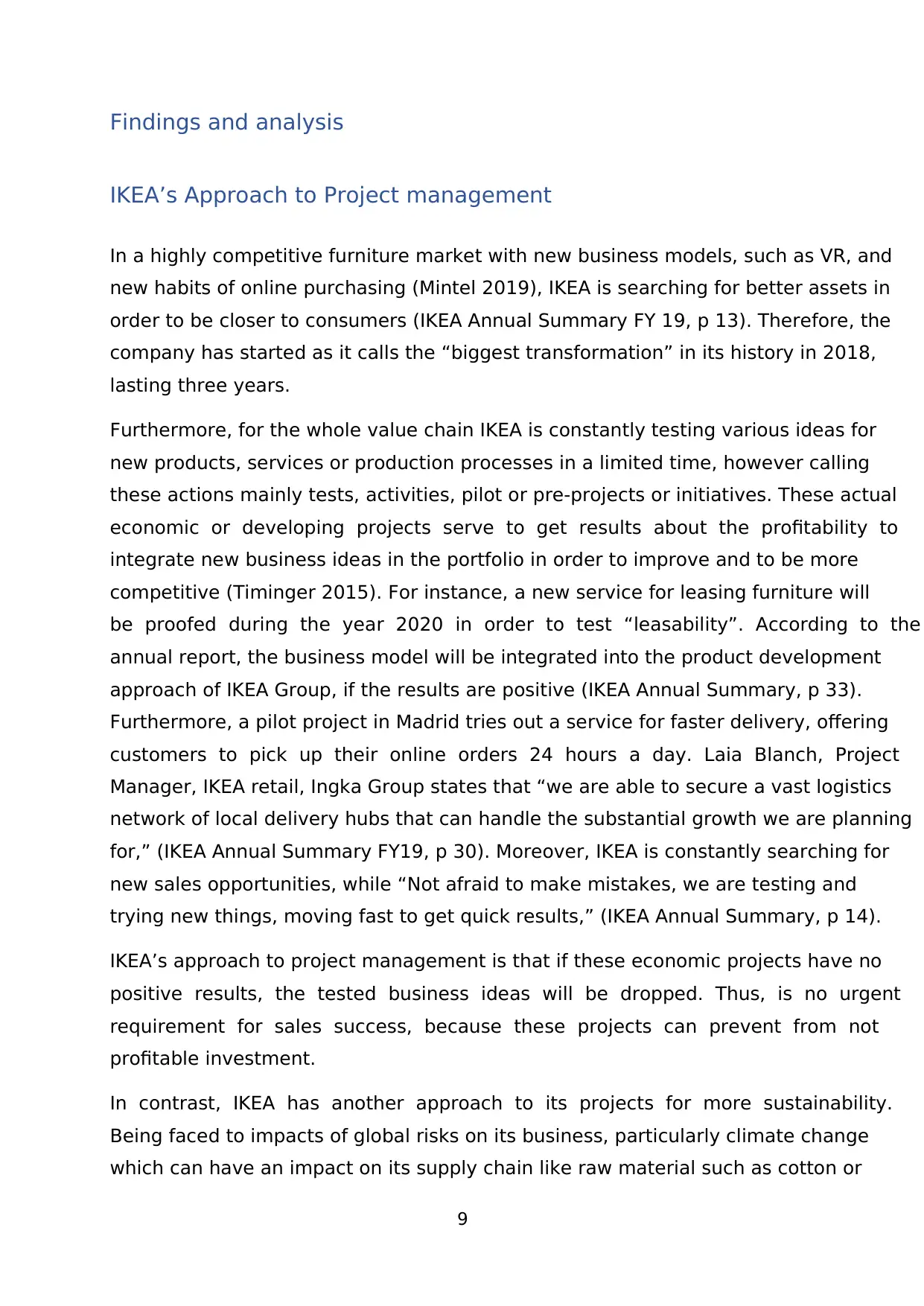
9
Findings and analysis
IKEA’s Approach to Project management
In a highly competitive furniture market with new business models, such as VR, and
new habits of online purchasing (Mintel 2019), IKEA is searching for better assets in
order to be closer to consumers (IKEA Annual Summary FY 19, p 13). Therefore, the
company has started as it calls the “biggest transformation” in its history in 2018,
lasting three years.
Furthermore, for the whole value chain IKEA is constantly testing various ideas for
new products, services or production processes in a limited time, however calling
these actions mainly tests, activities, pilot or pre-projects or initiatives. These actual
economic or developing projects serve to get results about the profitability to
integrate new business ideas in the portfolio in order to improve and to be more
competitive (Timinger 2015). For instance, a new service for leasing furniture will
be proofed during the year 2020 in order to test “leasability”. According to the
annual report, the business model will be integrated into the product development
approach of IKEA Group, if the results are positive (IKEA Annual Summary, p 33).
Furthermore, a pilot project in Madrid tries out a service for faster delivery, offering
customers to pick up their online orders 24 hours a day. Laia Blanch, Project
Manager, IKEA retail, Ingka Group states that “we are able to secure a vast logistics
network of local delivery hubs that can handle the substantial growth we are planning
for,” (IKEA Annual Summary FY19, p 30). Moreover, IKEA is constantly searching for
new sales opportunities, while “Not afraid to make mistakes, we are testing and
trying new things, moving fast to get quick results,” (IKEA Annual Summary, p 14).
IKEA’s approach to project management is that if these economic projects have no
positive results, the tested business ideas will be dropped. Thus, is no urgent
requirement for sales success, because these projects can prevent from not
profitable investment.
In contrast, IKEA has another approach to its projects for more sustainability.
Being faced to impacts of global risks on its business, particularly climate change
which can have an impact on its supply chain like raw material such as cotton or
Findings and analysis
IKEA’s Approach to Project management
In a highly competitive furniture market with new business models, such as VR, and
new habits of online purchasing (Mintel 2019), IKEA is searching for better assets in
order to be closer to consumers (IKEA Annual Summary FY 19, p 13). Therefore, the
company has started as it calls the “biggest transformation” in its history in 2018,
lasting three years.
Furthermore, for the whole value chain IKEA is constantly testing various ideas for
new products, services or production processes in a limited time, however calling
these actions mainly tests, activities, pilot or pre-projects or initiatives. These actual
economic or developing projects serve to get results about the profitability to
integrate new business ideas in the portfolio in order to improve and to be more
competitive (Timinger 2015). For instance, a new service for leasing furniture will
be proofed during the year 2020 in order to test “leasability”. According to the
annual report, the business model will be integrated into the product development
approach of IKEA Group, if the results are positive (IKEA Annual Summary, p 33).
Furthermore, a pilot project in Madrid tries out a service for faster delivery, offering
customers to pick up their online orders 24 hours a day. Laia Blanch, Project
Manager, IKEA retail, Ingka Group states that “we are able to secure a vast logistics
network of local delivery hubs that can handle the substantial growth we are planning
for,” (IKEA Annual Summary FY19, p 30). Moreover, IKEA is constantly searching for
new sales opportunities, while “Not afraid to make mistakes, we are testing and
trying new things, moving fast to get quick results,” (IKEA Annual Summary, p 14).
IKEA’s approach to project management is that if these economic projects have no
positive results, the tested business ideas will be dropped. Thus, is no urgent
requirement for sales success, because these projects can prevent from not
profitable investment.
In contrast, IKEA has another approach to its projects for more sustainability.
Being faced to impacts of global risks on its business, particularly climate change
which can have an impact on its supply chain like raw material such as cotton or
Paraphrase This Document
Need a fresh take? Get an instant paraphrase of this document with our AI Paraphraser
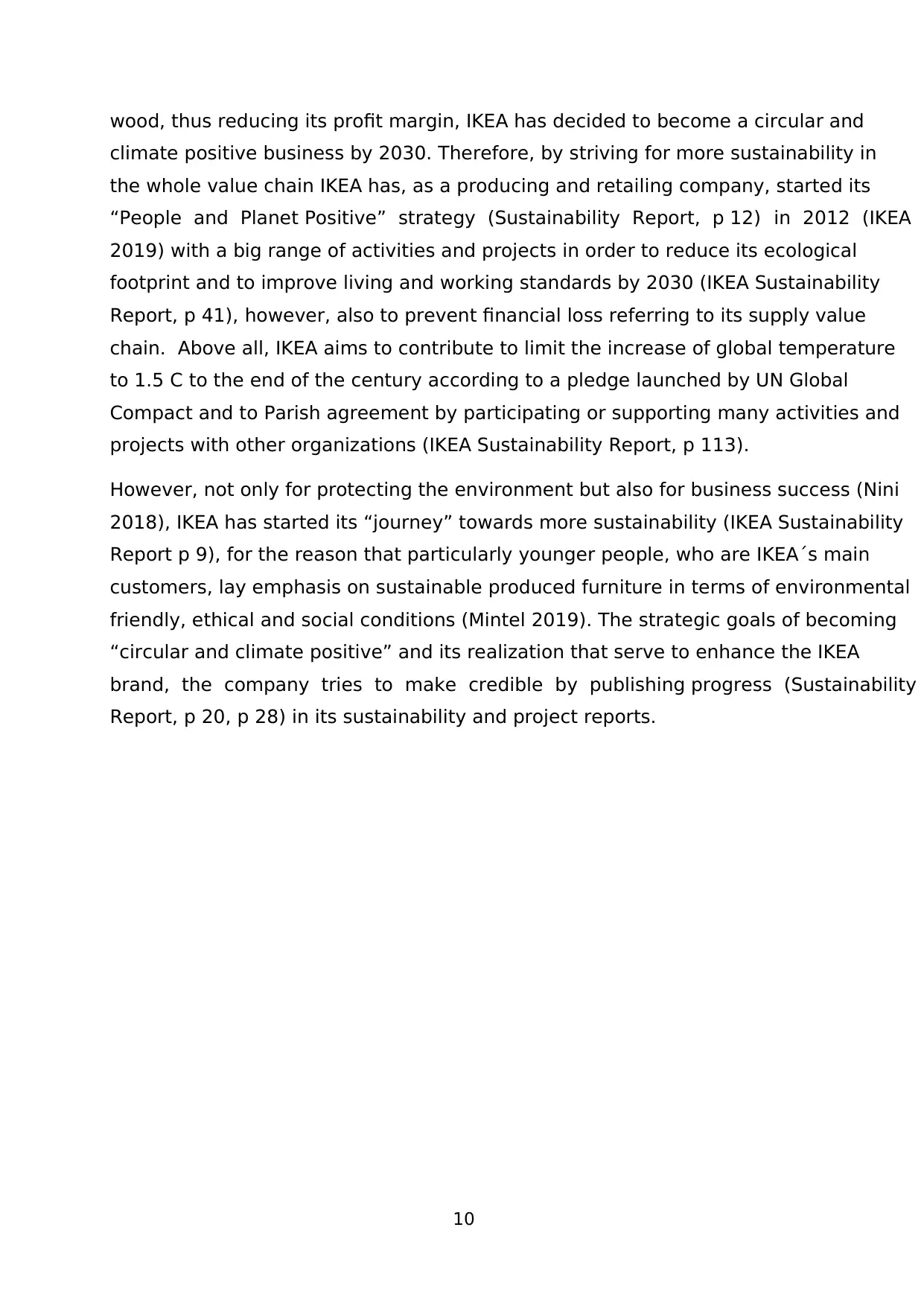
10
wood, thus reducing its profit margin, IKEA has decided to become a circular and
climate positive business by 2030. Therefore, by striving for more sustainability in
the whole value chain IKEA has, as a producing and retailing company, started its
“People and Planet Positive” strategy (Sustainability Report, p 12) in 2012 (IKEA
2019) with a big range of activities and projects in order to reduce its ecological
footprint and to improve living and working standards by 2030 (IKEA Sustainability
Report, p 41), however, also to prevent financial loss referring to its supply value
chain. Above all, IKEA aims to contribute to limit the increase of global temperature
to 1.5 C to the end of the century according to a pledge launched by UN Global
Compact and to Parish agreement by participating or supporting many activities and
projects with other organizations (IKEA Sustainability Report, p 113).
However, not only for protecting the environment but also for business success (Nini
2018), IKEA has started its “journey” towards more sustainability (IKEA Sustainability
Report p 9), for the reason that particularly younger people, who are IKEA´s main
customers, lay emphasis on sustainable produced furniture in terms of environmental
friendly, ethical and social conditions (Mintel 2019). The strategic goals of becoming
“circular and climate positive” and its realization that serve to enhance the IKEA
brand, the company tries to make credible by publishing progress (Sustainability
Report, p 20, p 28) in its sustainability and project reports.
wood, thus reducing its profit margin, IKEA has decided to become a circular and
climate positive business by 2030. Therefore, by striving for more sustainability in
the whole value chain IKEA has, as a producing and retailing company, started its
“People and Planet Positive” strategy (Sustainability Report, p 12) in 2012 (IKEA
2019) with a big range of activities and projects in order to reduce its ecological
footprint and to improve living and working standards by 2030 (IKEA Sustainability
Report, p 41), however, also to prevent financial loss referring to its supply value
chain. Above all, IKEA aims to contribute to limit the increase of global temperature
to 1.5 C to the end of the century according to a pledge launched by UN Global
Compact and to Parish agreement by participating or supporting many activities and
projects with other organizations (IKEA Sustainability Report, p 113).
However, not only for protecting the environment but also for business success (Nini
2018), IKEA has started its “journey” towards more sustainability (IKEA Sustainability
Report p 9), for the reason that particularly younger people, who are IKEA´s main
customers, lay emphasis on sustainable produced furniture in terms of environmental
friendly, ethical and social conditions (Mintel 2019). The strategic goals of becoming
“circular and climate positive” and its realization that serve to enhance the IKEA
brand, the company tries to make credible by publishing progress (Sustainability
Report, p 20, p 28) in its sustainability and project reports.
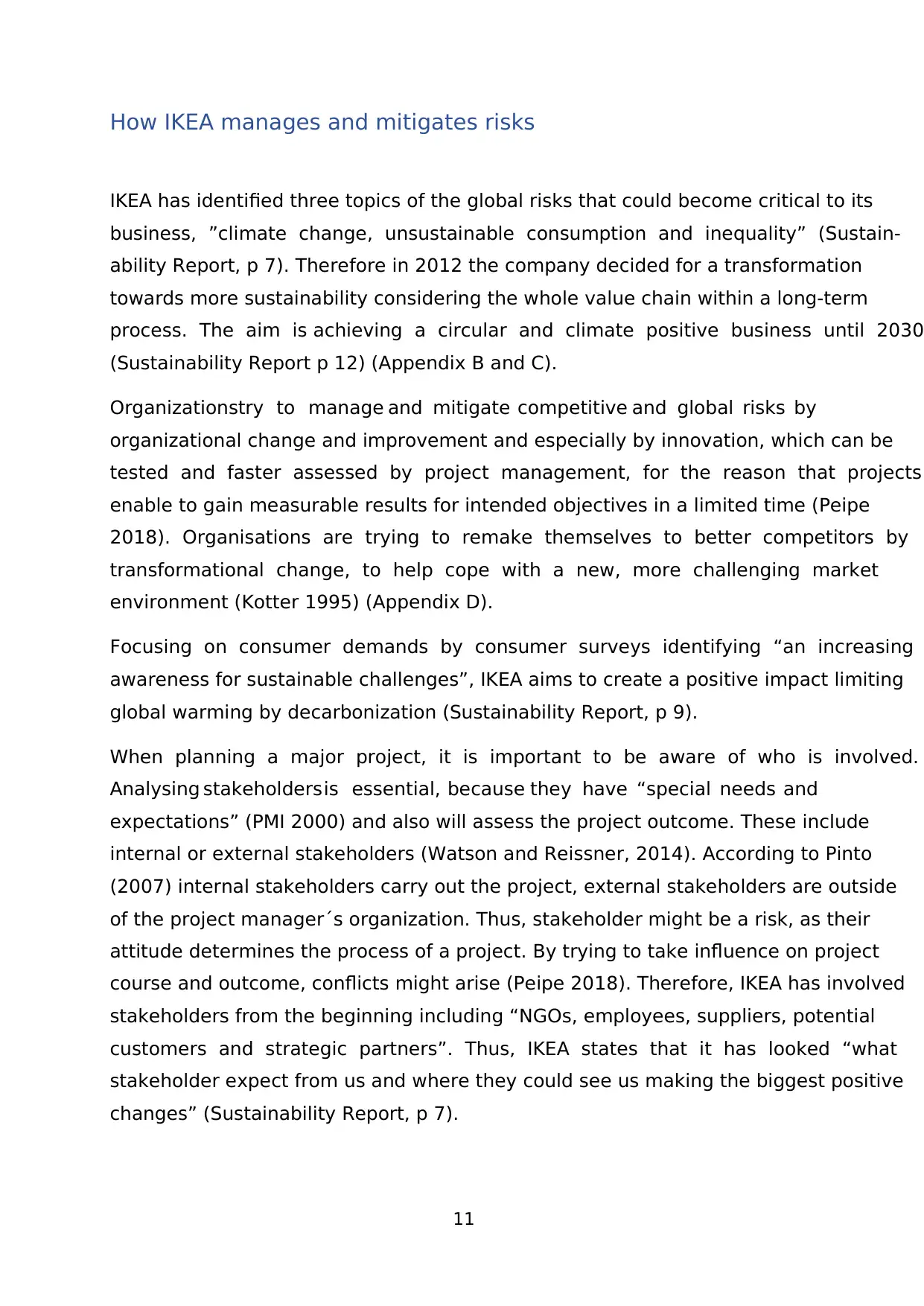
11
How IKEA manages and mitigates risks
IKEA has identified three topics of the global risks that could become critical to its
business, ”climate change, unsustainable consumption and inequality” (Sustain-
ability Report, p 7). Therefore in 2012 the company decided for a transformation
towards more sustainability considering the whole value chain within a long-term
process. The aim is achieving a circular and climate positive business until 2030
(Sustainability Report p 12) (Appendix B and C).
Organizationstry to manage and mitigate competitive and global risks by
organizational change and improvement and especially by innovation, which can be
tested and faster assessed by project management, for the reason that projects
enable to gain measurable results for intended objectives in a limited time (Peipe
2018). Organisations are trying to remake themselves to better competitors by
transformational change, to help cope with a new, more challenging market
environment (Kotter 1995) (Appendix D).
Focusing on consumer demands by consumer surveys identifying “an increasing
awareness for sustainable challenges”, IKEA aims to create a positive impact limiting
global warming by decarbonization (Sustainability Report, p 9).
When planning a major project, it is important to be aware of who is involved.
Analysing stakeholders is essential, because they have “special needs and
expectations” (PMI 2000) and also will assess the project outcome. These include
internal or external stakeholders (Watson and Reissner, 2014). According to Pinto
(2007) internal stakeholders carry out the project, external stakeholders are outside
of the project manager´s organization. Thus, stakeholder might be a risk, as their
attitude determines the process of a project. By trying to take influence on project
course and outcome, conflicts might arise (Peipe 2018). Therefore, IKEA has involved
stakeholders from the beginning including “NGOs, employees, suppliers, potential
customers and strategic partners”. Thus, IKEA states that it has looked “what
stakeholder expect from us and where they could see us making the biggest positive
changes” (Sustainability Report, p 7).
How IKEA manages and mitigates risks
IKEA has identified three topics of the global risks that could become critical to its
business, ”climate change, unsustainable consumption and inequality” (Sustain-
ability Report, p 7). Therefore in 2012 the company decided for a transformation
towards more sustainability considering the whole value chain within a long-term
process. The aim is achieving a circular and climate positive business until 2030
(Sustainability Report p 12) (Appendix B and C).
Organizationstry to manage and mitigate competitive and global risks by
organizational change and improvement and especially by innovation, which can be
tested and faster assessed by project management, for the reason that projects
enable to gain measurable results for intended objectives in a limited time (Peipe
2018). Organisations are trying to remake themselves to better competitors by
transformational change, to help cope with a new, more challenging market
environment (Kotter 1995) (Appendix D).
Focusing on consumer demands by consumer surveys identifying “an increasing
awareness for sustainable challenges”, IKEA aims to create a positive impact limiting
global warming by decarbonization (Sustainability Report, p 9).
When planning a major project, it is important to be aware of who is involved.
Analysing stakeholders is essential, because they have “special needs and
expectations” (PMI 2000) and also will assess the project outcome. These include
internal or external stakeholders (Watson and Reissner, 2014). According to Pinto
(2007) internal stakeholders carry out the project, external stakeholders are outside
of the project manager´s organization. Thus, stakeholder might be a risk, as their
attitude determines the process of a project. By trying to take influence on project
course and outcome, conflicts might arise (Peipe 2018). Therefore, IKEA has involved
stakeholders from the beginning including “NGOs, employees, suppliers, potential
customers and strategic partners”. Thus, IKEA states that it has looked “what
stakeholder expect from us and where they could see us making the biggest positive
changes” (Sustainability Report, p 7).
⊘ This is a preview!⊘
Do you want full access?
Subscribe today to unlock all pages.

Trusted by 1+ million students worldwide
1 out of 26
Related Documents
Your All-in-One AI-Powered Toolkit for Academic Success.
+13062052269
info@desklib.com
Available 24*7 on WhatsApp / Email
![[object Object]](/_next/static/media/star-bottom.7253800d.svg)
Unlock your academic potential
Copyright © 2020–2025 A2Z Services. All Rights Reserved. Developed and managed by ZUCOL.




